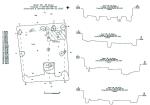Summary (English)
EXPLORATIONS NEAR THE VILLAGE OF GRADISHTE (Andrei Aladzhov – alajov@gmail.com, Stanimir Stoichev) The site was a multilayer settlement of the Late Bronze Age, Late Antiquity and the Middle Ages. It was situated on a slope on the left bank of Pakosha River. The most intensive occupation of the site was during the second half of the 4th – beginning of the 5th centuries AD and the 9th – 10th centuries AD. In Sector West, a Late Antique building was excavated; the lower parts of the walls were in rubble masonry, while the upper parts were built of wattle-and-daub. A hearth and a storage pit were discovered in the building. A pottery kiln was explored close to the building, containing over six bowls and a jug of the 4th – 5th centuries AD. Two ovens were discovered: the first one with unspecified date and the second was a domestic oven of the Middle Ages. Twenty-five pits were discovered: six of Late Antiquity, 14 of the Late Bronze and the Early Iron Ages, five with an unspecified date. Several houses of the Late Bronze Age were documented. In Sector East, an Early Mediaeval dugout 3.20 m by 3.20 m in size was discovered. Postholes of the structure that supported the roof were documented. A storage pit was discovered in the dugout, containing five bone awls, five knucklebones, a terracotta spindle whorl and sherds. In Sector Center, a Late Antique building was excavated; its foundations were built of stones, while the upper parts of the walls were clay. The building was probably storage; several querns and a number of farming tools were discovered inside. An Early Mediaeval dugout was set up within the remains of the building. A stone stove was discovered in the dugout and part of a Roman silver mirror was found in its debris. A Late Antique well was explored; it was reused during the Middle Ages. Bucket handles and hooks and sherds from pitchers were found around the opening of the well. Pits containing fragmentary dolia were discovered. One of the pits contained five human skulls and coins of Constantius II and subsequent Roman emperors of the second half of the 4th century AD.
- Andrei Aladzhov - Archaeological Institute with Museum
- Stanimir Stoichev - Regional Museum of History – Shumen
Director
- Andrei Aladzhov - Archaeological Institute with Museum
- Stanimir Stoichev - Regional Museum of History – Shumen
Team
Research Body
- Archaeological Institute with Museum
- Regional Museum of History – Shumen






![Download [PDF]](/excavation/skins/fasti/images/results/download_sml.png)


